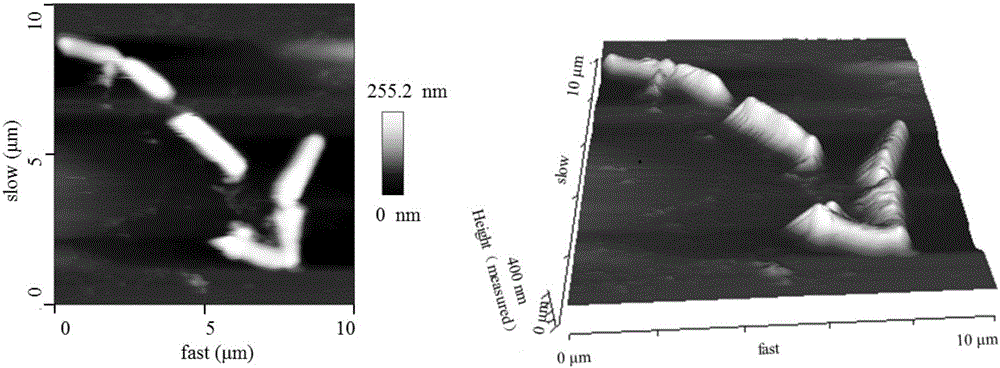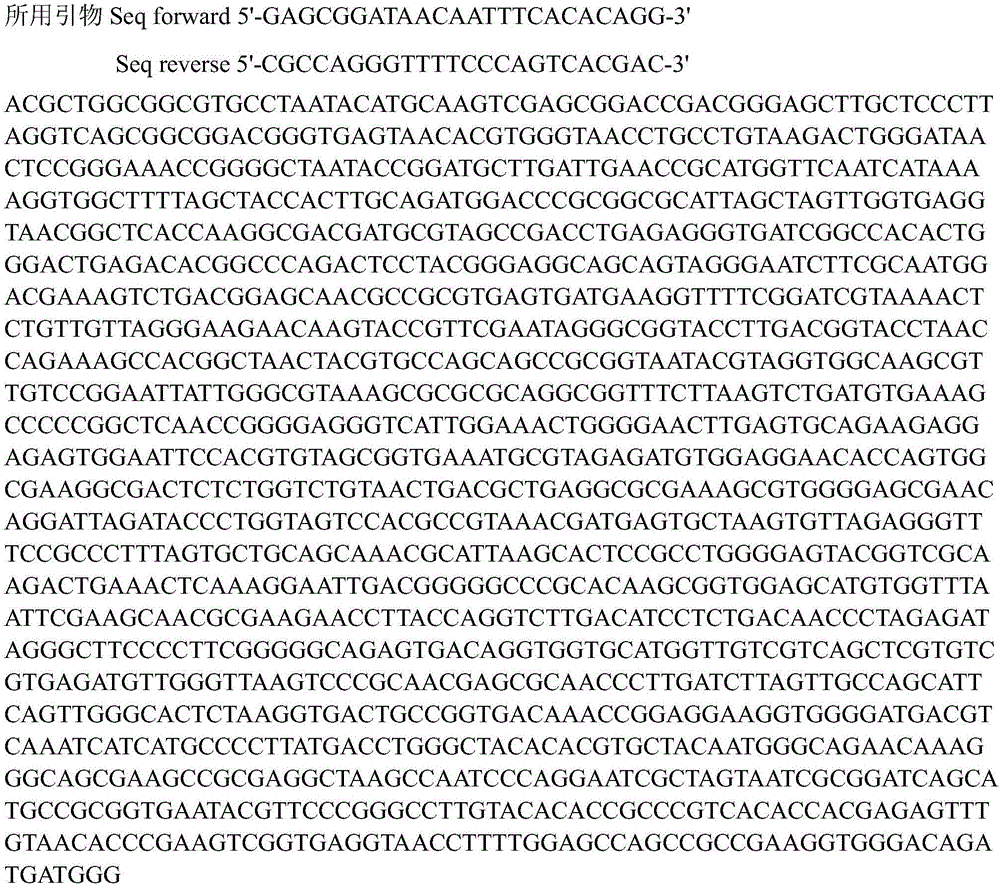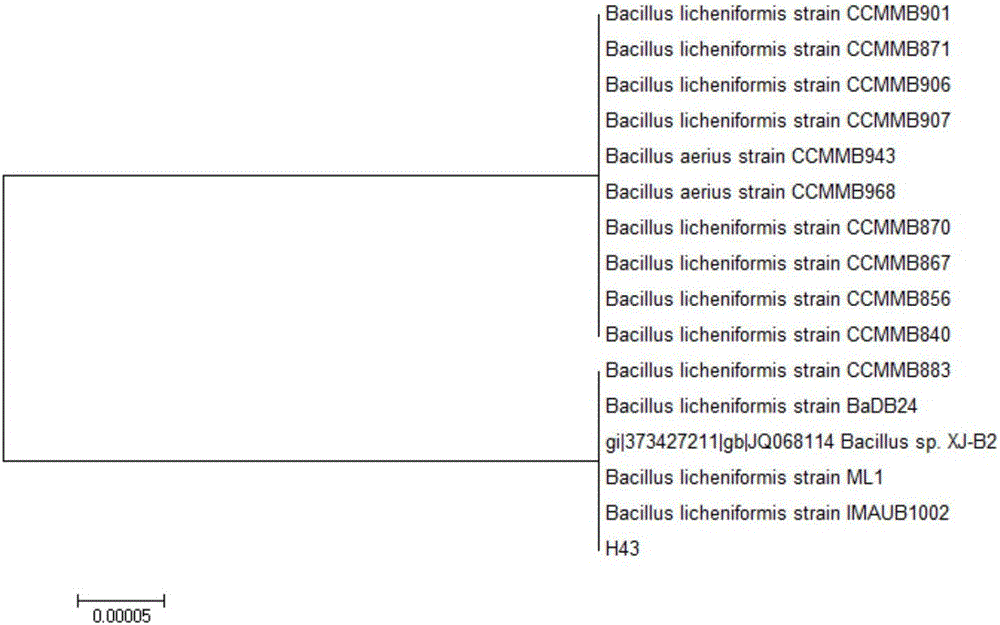Medium thermophilic bacillus licheniformis strain and application thereof in treatment on high-temperature oil-bearing wastewater
A technology of Bacillus licheniformis and oily sewage, applied in biological water/sewage treatment, water/sludge/sewage treatment, bacteria, etc., can solve problems such as the application of heat-resistant Bacillus licheniformis
- Summary
- Abstract
- Description
- Claims
- Application Information
AI Technical Summary
Problems solved by technology
Method used
Image
Examples
Embodiment 1
[0024] Embodiment 1: the screening of bacillus licheniformis (Bacillus licheniformis) H43 bacterial strain;
[0025] 1. Sampling: Collect crude oil (outlet pipeline of the three-phase separator, flow for 1 min before sampling) and soil (sampling after removing 0.5 cm of surface soil) from Tainan Oilfield Combined Processing Station in a sterile container, and then store at 4°C for later use .
[0026] 2. Enrichment: Take oil-contaminated soil samples respectively, put them into 250mL triangular Erlenmeyer flasks with 100mL medium (1mL trace element solution plus 10mL mineral salt solution, add sterile water to 100mL) according to the ratio of 5%, shake the table Cultivate for 7d (55°C, 160rpm). Take 5 mL of the enrichment solution and transfer it to the same fresh medium, and culture it under the same conditions for 7 days, so that the enrichment culture is continued for 7 times.
[0027] 3. Separation: Configure LB solid medium, after autoclaving (121°C, 20min), take it out...
Embodiment 2
[0032] Embodiment 2: Morphological and physiological and biochemical characteristics of Bacillus licheniformis (Bacillus licheniformis) H43
[0033] 1. Test method
[0034] Refer to the experimental method of "Bergey's Mannual of Syetematic Bacteriology" to detect its Gram staining, cell size and shape, growth temperature, growth pH range, NaCl tolerance, starch hydrolysis, lipase activity, V-P, methyl red, glucose Acid production experiment.
[0035] 2. Test results
[0036] The results showed that the bacterium was Gram-positive, arranged in a rod shape under the microscope, facultatively aerobic, with a growth temperature of 40-60°C, a growth pH range of 6-9, and a NaCl tolerance of 0%-4%. , V-P is positive, methyl red test is negative, can use glucose to produce acid, hydrolyze starch, use olive oil to emulsify to produce lipase, etc.
Embodiment 3
[0037] Embodiment 3: the 16sDNA identification of bacillus licheniformis (Bacillus licheniformis) H43 bacterial strain:
[0038] 1. Test strain: Bacillus licheniformis (Bacillus licheniformis) H43 of the present invention
[0039] 2. Test method:
[0040] ① Obtain bacteria with good activity: first recover the H43 strain, take 100uL of the frozen storage solution and inject it into 10mL of LB liquid medium, and culture it on a shaker at 55°C and 160rpm for 12-24h. Streak culture the shaken bacterial liquid, culture in a 55°C incubator for 24 hours, pick a single clone on the plate, inoculate it into a test tube of LB liquid medium, shake it at 55°C, and incubate at 160rpm for 12-24h.
[0041] ②Bacterial DNA extraction method (Takara kit)
[0042]③ Bacterial 16SrDNA amplification
[0043] Primers used: Seqforward5'-GAGCGGATAACAATTTCACACAGG-3'
[0044] Seqreverse 5'-CGCCAGGGTTTTTCCCAGTCACGAC-3'
[0045] The results of the identification are attached to the manual figure 2...
PUM
| Property | Measurement | Unit |
|---|---|---|
| temperature | aaaaa | aaaaa |
Abstract
Description
Claims
Application Information
 Login to View More
Login to View More - R&D
- Intellectual Property
- Life Sciences
- Materials
- Tech Scout
- Unparalleled Data Quality
- Higher Quality Content
- 60% Fewer Hallucinations
Browse by: Latest US Patents, China's latest patents, Technical Efficacy Thesaurus, Application Domain, Technology Topic, Popular Technical Reports.
© 2025 PatSnap. All rights reserved.Legal|Privacy policy|Modern Slavery Act Transparency Statement|Sitemap|About US| Contact US: help@patsnap.com



